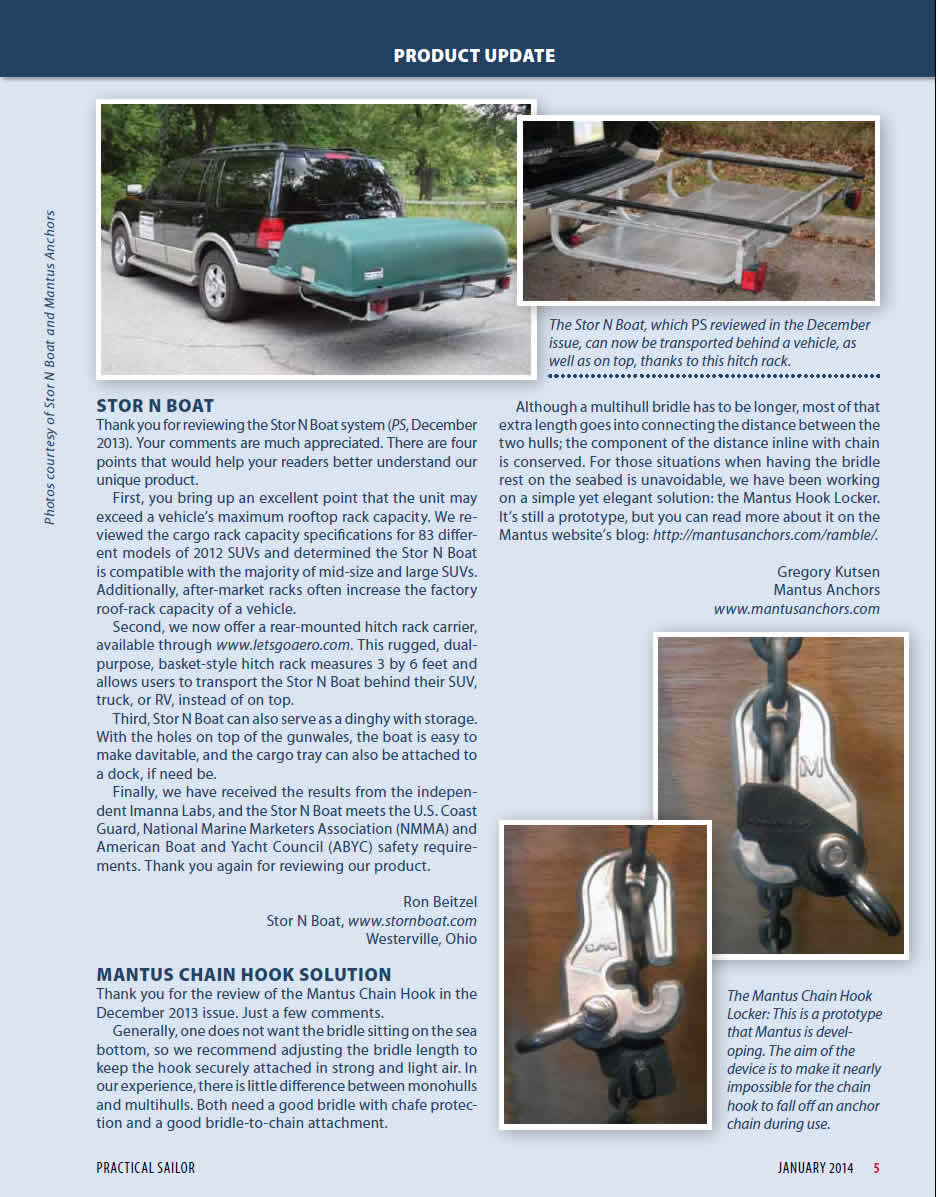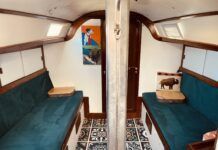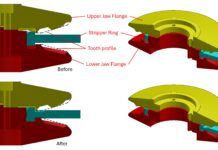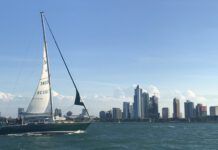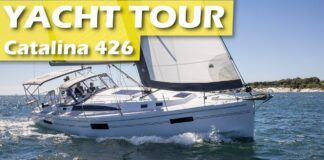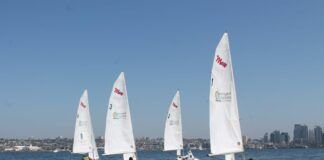Photo courtesy of Ed WhitePhoto courtesy of Neal Parker
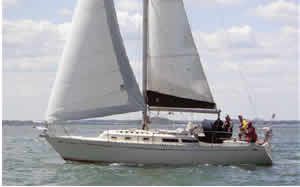
In reference to your review of water heaters in the December 2013 issue: It brought to mind an issue that many of us have dealt with over time and on different boats. Odor in freshwater systems can be a horrible problem.
Your mention of dissimilar metals and also chlorinated water rang a bell with me. The pressure-relief valves on many water heaters are made of bronze or another metal. One year, on the advice of a friend, I removed my water heaters valve for cleaning and found some of the most foul hydrogen-sulfide odor imaginable, along with some black gooey substance. Its a powerful smell. Since then, Ive been removing, cleaning, and flushing that valve at the start and in the middle of each season; 95 percent of my water odor problems disappeared.
The use of hypochlorite disinfecting treatments basically results in chlorine attacking the less noble metals in the plumbing. I advise using these treatments sparingly and keeping your pressure valve cleaned and flushed. Im fortunate that on my boat, access is not a problem. I wonder how necessary it is to add what is basically bleach to a water system that is used frequently and gets tanks refilled a few times each season from reputable municipal water supply systems.
Ed White
Caliente, Cal 35
Hull, Mass.
In regard to your September 2013 review of LED spotlights: As a non-cruising sailor who only occasionally needs a spotlight, I think an important characteristic of a spotlight would be how long it keeps a usable charge. Knowing the usable charge life would allow you to have charge spotlight on your maintenance schedule.
Anthony Broom
Sweet Adeline, Catalina 22
Stony Creek, Conn.
Giving an accurate usable charge life for a battery would be challenging because battery life is impacted by so many variables, including temperature and whether they are stored or left in the spotlight. Batteries left in our Florida garage discharge in 60 days during the summer, even if the spotlight isn’t used. We suggest a routine of charging the batteries monthly.
Every rechargeable battery has a limited number of charging cycles, and over time, if the lights are used and recharged often, their battery-life capacity diminishes. None of the spotlights we tested featured low-battery indicators; however, they all showed red when charging and green when charge was complete.
Photo courtesy of Ed WhitePhoto courtesy of Neal Parker

I very much appreciate the service that Practical Sailor provides. I read the recent article on snubbers (PS, November 2013), and once again, you probably kicked an ant hill. I offer a few comments on the topic; note that throughout this letter, I use made-up figures.
You may find the following website to be valuable. It provides several graphs for calculating parameters that relate to dynamic loading of anchoring systems for boats: http://alain.fraysse.free.fr/sail/rode/rode.htm
Comparing Snubber Systems: I can’t think of a practical way to accurately calculate the amount of energy a snubber system will absorb. I think the only way to gain meaningful information is to perform tests and collect data. Below is a proposal.
If the last link of an anchor chain is picked up at 270 pounds of tension (100 feet of 3/8-inch chain at 5:1), and the tension on the anchor rode continues to increase, at some point (say, at 2,000 pounds), the maximum safe working load of the anchoring tackle will be reached. The amount of energy absorbed by the decreasing catenary of the anchor rode can be calculated with satisfactory accuracy by summing the data readings that were taken during the tensioning process: (0*275) + (1*303) + (2*333) + (3*366) + (…) + (21*2035). The values of 303, 333, 366, … 2035 are the tension readings at 1-inch increments.
In this scenario, about 276,000-inch-pounds of energy is required to tension the anchor rode from 275 pounds to 2,035 pounds. If a snubber is added to the anchoring system, then the system will have more elasticity, and hopefully, it will absorb more energy than a chain-only anchor rode. That said, sometimes snubbers will carry a smaller safe working load than the chain.
The point is that this analysis lends itself to comparing various snubber systems that many people will find useful. This analysis requires some assumptions and simplifications, but they may not significantly dilute the results.
Initial Tension: As you mentioned in the November 2013 article, one advantage of an all-chain rode is that some energy is required to lift portions of it off of the bottom before the last link is lifted. This contrasts to an all-nylon rode which requires less energy before it is nearly straight (more on this later).
I don’t think that the energy required to lift portions of the chain off of the bottom should be ignored. I suggest that initial starting point for comparison tests of snubbers should be the average tension on the anchor rode in a given situation. If the last link tension is used for comparison, an all-nylon rode will always absorb more energy than a chain rode or a combination rope/chain rode.
Final Tension: I suggest that the safe working load of the weakest link in the anchoring system should be used as the upper limit of the test.
This may be impractical to perform at your test setup due to structural limitations, but the test could be done in two phases. The first phase would mimic the profile of an anchored boat. After sufficient tension is applied to lift the last link off the ground, a second test setup would be used to replicate the depth of the catenary; ignore the water depth.
Combination Chain/Rope Rodes: On my former boat, a 36-foot C&C 110, I had an anchor rode with about 60 feet of chain and the rest nylon. This allowed me to anchor in 20 feet of water, with a 4:1 scope, and automatically have a 20-foot snubber. Perfect. If the wind kicked up, I let out more rope and got more scope and a longer snubber. Perfect again.
I recommend using braided rope in a chain/rope anchor rode rather than three-strand because three-strand can hockle and be hard on anchor-chain gypsies.
Rope Rodes and Yawing: I have been in some blows where the boat is yawing back and forth with significant force, and I have observed that the rope rode forms a fairly large horizontal catenary as the bow hunts. I guess that the depth of the catenary is about half the length of the boat. As the bow falls to leeward and tugs on the rode, the rode vibrates as it surges through the water. In practice, nylon rodes are not straight when boat is yawing.
Yawing and Pitching Loads: In addition to yawing loads, large waves and ocean swells can impose a large pitching motion on the boat. When the anchor rode is tight and a large wave lifts the bow high, the resulting load on the anchor line-and snubber-can be tremendous.
Bridle Snubber: The article did not mention a bridle snubber system. I currently use such a system on my power boat. When the boat swings to one side, only one leg of the bridle takes the tension. So, in effect, the snubber system receives half the wear of a single line system, and if one snubber line fails, the remaining one should still be functional. I wonder if a bridle system has slightly less yawing, even for a monohull. If the attachment points are well spaced from the centerline of the hull, the leeward snubber will come into play a couple of feet before a single snubber would, if it were attached on centerline.
Neal Parker
Navigator, Kadey Krogen 48
Seattle, Wash.
There is no need to spend money on a rescue magnet when you can get one out of a discarded speaker. There is a permanent magnet in most speakers-it is part of what makes a speaker work. The bigger the permanent magnet, the stronger it is. Just tie one to a line or string, and you have a rescue magnet. I have three of them, and they are quite useful.
C. Henry Depew
Sisu 26
Tallahassee, Fla.
I would like to encourage Practical Sailor to expand its assessments to include the practical information sailors should look for when shopping for marine gear-not just test results substantiating product performance.
For example, your test of marinized stereos (PS, April 2013) focused on your usual bench test evaluation criteria and provided valid and absolutely correct information regarding the products. The report also focused on splash proof but completely missed the most practical feature. None of the products evaluated offer a sun cover, and I assure you that after a year or two, their information-packed, back-lit displays will no longer be visible at all due to extended exposure to direct sunlight in the cockpit.
I learned the hard way. I have an excellent Poly-Planar stereo whose display is not legible day or night, and I also have a Standard Horizon VHF whose cord over the wires from the microphone to the radio was so severely deteriorated by the sun that the unit had to be replaced. When I replaced the VHF, I purchased a Ray 49, which has a sun cover. Today, I am not aware of any VHF radio manufacturer that offers a protective sun cover for its radio.
Richard Paden
Petite Cherie
Severna Park, Md.
You bring up a good point. While none of the stereos we tested come standard with sun covers, some brands offer the covers as optional accessories. For instance, Fusion-maker of our Editors Choice stereo pick, the MS-RA200SD-markets a flush-mount marine cover that has a tinted, UV-stabilized poly-carbonate front panel and a water-resistant seal. Poly-Planar and Sony also offer similar sun/water covers. Chances are, if an electronics manufacturer markets a marine stereo, they also offer a cover for it as an optional purchase.
In your December 2013 issue, the Riprap section had an article on NOAA ceasing making paper charts. I would have instead said they are ceasing printing paper charts, as what they now provide is making it even easier for sailors to have paper backups to the onboard chartplotter on board.
When I ran across their trial of distributing charts as PDF files, I wondered how to print them at home. Well, NOAA already has that covered with their BookletCharts (www.nauticalcharts.noaa.gov), which are all set up to print on a letter-size printer and even include some Coast Pilot notes and up-to-date Notices to Mariners.
These files also make it possible for any device that can view PDF files to be an electronic chartplotter backup or to get a full-size chart printed in a hurry at a copy shop.
Tom Shield
Vadnais Heights, Minn.
I have been aghast at how ill-conceived the standard system is for the design of inflatable PFD-harnesses for sailors. Practical Sailor is uniquely positioned to research the issue and inform the sailing community of better-designed systems.
As a rock climber, I have some serious concerns about the design of inflatable PFD-harnesses, and actually about the entire jackline/tether/harness systems employed by most boats. A good system would keep crew aboard and minimize the forces required to do so. As a climber, I know that the farther you fall, the greater the forces generated, and the shorter the distance over which you come to a stop, the greater the force.
Typical jackline system designs allow sailors to fall way too far, and then jerk them to an abrupt stop. Reports of failed gear and internal injuries abound for this reason. Offshore racing regulations have been beefed up to require bigger and stronger gear to reduce failures, but this has resulted in more injuries. The problem is in system design, not the strength of the gear. Even extremely strong gear can fail easily, and even short falls can cause serious trauma.
Jacklines are typically at deck level. In addition to being a tripping hazard, this requires a long tether, therefore, enabling longer falls. If jacklines were strung at chest level, or close to it, tethers could be much shorter, and long falls prevented. This would have the added benefit of giving the crew something to hold on to and act as an extra high lifeline. An adjustable tether, like those used by arborists, would allow crews to extend their range as necessary, and minimize length when possible to reduce the potential fall distance.
Jacklines and tethers are almost always made of nylon webbing, which has very little elasticity. As result, a fall can generate high forces. A way to avoid this would be to design elasticity into the system. Jacklines should be made of webbing with some degree of elasticity, like the polyester webbing used for slacklines; it is stronger and more elastic than mil-spec webbing. Tethers should include a shock absorber like those used in rock climbing and industrial applications.
A well-designed harness should fit around the upper chest, under the armpits where humans have significant muscle mass and strength. Even a short fall in normal sailing harnesses, which sit way too low, will likely result in injury as the forces wind up on the lower rib cage, a relatively weak area. Climbing chest harnesses are designed to fit high on the chest.
I think a well-designed inflatable PFD with harness would actually be two separate systems. The chest-style harness with inflatable bladders distributed more broadly around the torso like a modern whitewater PFD, instead of bunched up around the neck like the crappy orange vests you had to wear as a kid that always float up over your head. The current designs try to integrate the PFD and harness into the same structure, which is a compromise to both systems.
Tripp Presnell
Piper, 1984 Najad 343
Beaufort, S.C.
